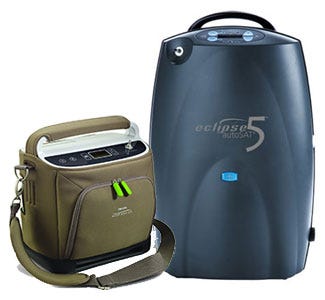Some Ideas on Portable Oxygen Concentrators You Need To Know
Wiki Article
Portable Oxygen Concentrators for Beginners
Table of ContentsFascination About Portable Oxygen ConcentratorsExcitement About Portable Oxygen ConcentratorsThe Best Strategy To Use For Portable Oxygen ConcentratorsPortable Oxygen Concentrators Can Be Fun For Everyone
Fixed oxygen concentrators were once the standard, but these containers can consider 50 extra pounds and were extremely difficult (Portable Oxygen Concentrators). Currently, portable oxygen concentrators do the job, and they can fit into a purse or handbag! The only thing you should bear in mind is that mobile concentrators have extra limited oxygen shipment capabilitiesThere are two primary types of portable oxygen concentrators: pulse dose and continual flow. As the name suggests, pulse dosage concentrators supply oxygen periodically, only triggering when you breathe in. This sort of tool is typically suggested for COPD people with restricted oxygen requirements, as the amount of O2 that a pulse dosage concentrator can supply is reasonably reduced.
This tool can provide up to 3,000 m, L of oxygen every min, while pulse dose devices tend to top out at 1250 m, L. Constant circulation tools are the go-to for many COPD people, as they're excellent for individuals who need two to five liters of oxygen a min.
Now that you have this guide to the various sorts of mobile oxygen equipments, select the most effective device with the assistance of your medical professional. You can explore our blogs to get more information about the sorts of mobile oxygen readily available and our various other items, like tubes and cannulas. Or you can call us straight with any kind of particular concerns you may have.
Rumored Buzz on Portable Oxygen Concentrators
We wondered exactly how well these portable oxygen concentrators would function in health centers. POC concentrators increase the percentage of oxygen in ambient air people breathe in, whenever they require an increase.When it comes to mobile oxygen treatment, there are 2 major choices for delivery. These are mobile oxygen cylinders which include compressed oxygen gas, or oxygen concentrators, which use a battery powered system to compress and filter air, in order to produce a regular supply of focused oxygen. In this article, AMS Compound Cylinders Technical Supervisor, Tony Morrin, compares the two, taking a look at the benefits and drawbacks of each oxygen shipment system for NHS clinical oxygen individuals in regards to patient freedom.

i loved this Mobile Oxygen Concentrator Oxygen purity is continually higher when supplied from cylinders it never goes down below 99. 6%, despite the circulation price called for. In battery-powered concentrators, pureness is influenced by flow rate, and might be 90% or less, depending upon the devices. Whilst oxygen concentrators can be helpful for people that require a reduced flow of oxygen, cylinders provide greater focus that can be much more ideal for individuals with high circulation demands.
Portable Oxygen Concentrators - An Overview
Both systems call for the patient to lug around equipment. For cyndrical tubes, this will certainly include lugging a bag (and periodically a cart) and for portable oxygen concentrators this will consist of the bag, cart and power charger. Weight sensible, mobile oxygen concentrators can be similar in weight, or often, lighter than conventional aluminium cyndrical tube systems.
They will certainly have to improve considerably if they are to give the very same degree of performance as equivalent composite cylinders. Oxygen always carries a safety risk. On one click hand, must cyndrical tubes spring a leak, they can develop an oxygen rich setting that can result in a boost in fire threat.

The difference is that there are considerable in advance costs to acquiring a mobile oxygen concentrator, but lower running expenses making use of cyndrical tubes allows the buyer to spread out the cost over an extended period of time. One small disadvantage of a mobile oxygen concentrator is the noise portable systems make a significant amount of noise throughout procedure, which several clients discover distracting.
Indicators on Portable Oxygen Concentrators You Need To Know

Our top quality carbon composite cylinders offer high stress (300 Bar), reduced weight, and NLL (Non-Limited Life) performance, and are accredited for use worldwide. Additional information about AMS Composite Cylinders Ltd can be discovered at .
Oxygen concentrators are developed with individual wheelchair in mind. Whether it's a desktop computer variation for home use or a smaller sized, light-weight version for on-the-go, these devices enable patients to relocate openly without being tethered to a fixed system. Particularly for the ones especially developed for transportability, individuals can carry them about, helping with traveling and everyday tasks with simplicity.
One of the significant conveniences of making use of an oxygen concentrator is the removal of the regular need to re-fill oxygen containers. This not just reduces the look what i found logistical challenges and reoccurring costs related to refills but likewise ensures that the customer has an extra foreseeable and constant source of oxygen. Oxygen concentrators are created to fit perfectly right into the home atmosphere.
Report this wiki page